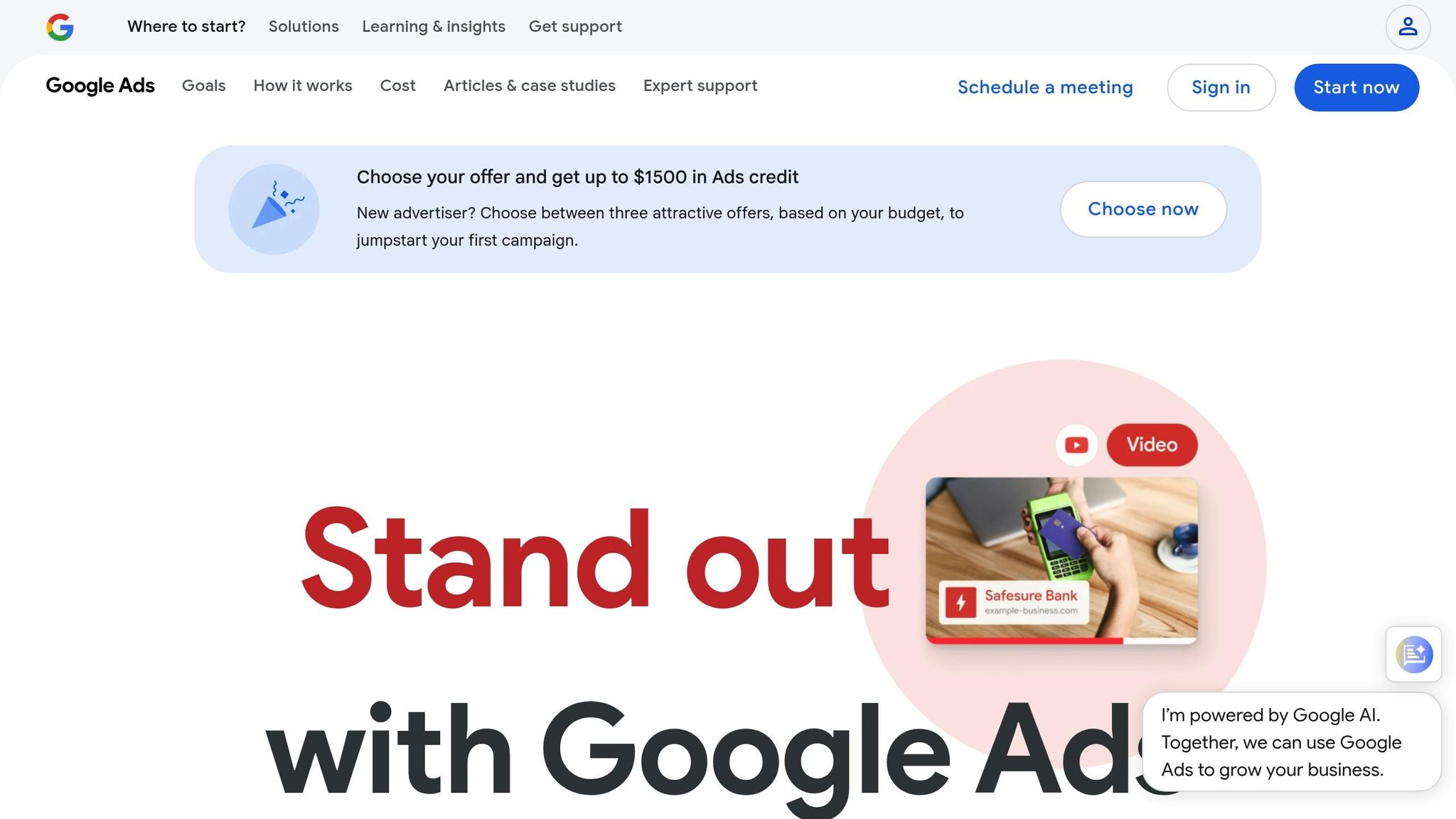Want to stop wasting ad dollars? Geo-targeting is your solution. It ensures your PPC ads reach the right people in the right places, cutting costs and boosting conversions. Here’s why it works:
- Cuts Wasted Spend: Focus your budget on local audiences who are more likely to convert.
- Drives Engagement: Location-specific ads increase user interaction by 84%.
- Improves ROI: 89% of marketers report higher sales with geo-targeted campaigns.
- Tracks Performance by Area: Pinpoint which locations deliver the best results and adjust accordingly.
Google Ads Location Targeting Made Simple | PPC GeoTargeting Tips for 2025

Common PPC Problems for Local Businesses
Failing to narrow down geographic targeting can turn PPC campaigns into costly missteps. Below are some common challenges that local businesses face when their PPC strategies lack proper focus.
Wide Targeting Wastes Money
One major pitfall is spending money on ads that target too broad an audience. Imagine a Chicago plumbing company whose ads show up in Miami search results. Every click from Miami is essentially throwing money away because the searcher is outside the service area and unlikely to convert. In fact, small businesses may lose up to 25% of their PPC budgets due to poor management and strategy mistakes. With the average cost per click reaching $4.66 in 2024, these losses can add up fast. For instance, a local business spending $1,000 monthly on PPC could be wasting around $250 just because of poor targeting.
Broad keyword choices make the problem worse. For example, if a local bakery bids on "wedding cakes", they might attract clicks from people planning destination weddings far outside their delivery area. These irrelevant clicks not only drain budgets but also lower the chances of converting visitors into customers.
Poor Conversion Rates from Wrong Audiences
Misguided targeting doesn’t just waste money – it also leads to disappointing conversion rates. Ads that reach the wrong audience bring in clicks that rarely turn into sales or leads. This mismatch can create a snowball effect: low conversion rates signal to ad platforms that the ads lack relevance, which may increase costs and reduce ad visibility over time.
Take a local fitness studio, for example. If its ads are shown to a nationwide audience, it might get plenty of clicks from fitness enthusiasts, but those clicks won’t translate into new memberships if the users live too far away. Similarly, a local HVAC company might end up paying for clicks from homeowners in other states – clicks that offer no real value to the business.
Hard to Compete with National Brands
Ineffective targeting also puts local businesses at a disadvantage when competing against national brands. These larger companies often dominate broad PPC auctions because they can outspend smaller businesses. With bigger budgets, national brands can bid higher on popular keywords, effectively pricing out local competitors.
On top of that, national companies often use advanced AI-driven tools and detailed audience data to optimize their campaigns. These technologies allow them to adjust bids in real time, something many smaller businesses can’t afford or don’t have the resources to manage. As a result, local businesses that fail to focus their targeting might find themselves competing in expensive markets where their natural strengths – like proximity and personalized service – don’t make much of an impact.
What Is Geo-Targeting in PPC and How It Works
Geo-targeting leverages geographic data to deliver PPC ads tailored to specific locations, adding a layer of precision that goes beyond just demographics. While traditional targeting focuses on factors like interests and behaviors, geo-targeting hones in on where users are physically located – or where they’ve shown interest in visiting – allowing for highly relevant ad placements.
The technology behind geo-targeting pulls from various data sources to determine user locations. These include GPS data from mobile devices, IP addresses that indicate general areas, Wi-Fi network details, and even Bluetooth signals. By combining these signals, PPC platforms can deliver ads that are not only relevant to user preferences but also to their physical or intended locations.
Here’s a closer look at how geo-targeting can refine your PPC campaigns.
Target Ads by Location
Platforms like Google Ads provide several options for location-based targeting. You can focus on entire countries, drill down to specific regions such as states, cities, or postal codes, or even define custom radius zones around particular areas. For businesses managing campaigns across multiple locations, some platforms allow bulk uploads of up to 1,000 locations, streamlining the process.
Two key targeting settings are available to fine-tune your approach:
- "Presence" targeting focuses on users who are physically in or regularly visit your selected locations.
- "Presence or Interest" targeting goes a step further, reaching users who are either in those areas or have expressed interest in them through their online behavior.
For instance, imagine Adrian wants to promote his hotel in Spain to English-speaking travelers in England. He could use geo-targeting to focus his ads on England and adapt the messaging to resonate with that audience. Additionally, excluding locations where your services aren’t available is just as important. This prevents unnecessary clicks and ensures your ad spend is used effectively.
Create Location-Specific Landing Pages
To maximize the impact of geo-targeting, it’s crucial to pair your ads with landing pages that feel local and relevant. These pages should reflect the area’s culture, events, and even language to establish a connection with visitors.
Since many geo-targeted ads are viewed on mobile devices, your landing pages must be mobile-friendly. This means they should load quickly, display properly on smaller screens, and include local details like phone numbers, addresses, and service areas.
Incorporating local keywords and phrases – such as neighborhood names, landmarks, or regional terms – can also make a big difference. These details help align your content with how people search in that area. By tracking performance metrics like conversions, bounce rates, or customer lifetime value by location, you can fine-tune your strategy and strengthen your overall approach to local markets.
How Geo-Targeting Fixes Local PPC Problems
Now that we’ve covered how geo-targeting works, let’s dive into how it directly solves some of the biggest headaches local businesses face with PPC campaigns. Whether it’s cutting down on wasted ad spend or boosting engagement, geo-targeting transforms these challenges into actionable benefits.
Reduces Wasted Ad Spend
One of the most immediate perks of geo-targeting is its ability to trim unnecessary spending by narrowing your audience to those most likely to convert. Instead of casting a wide net, you can focus your budget on people nearby who are genuinely interested in what you offer.
Take a local florist in Chicago, for example. Instead of targeting the entire city, they could zero in on users searching for terms like “birthday flowers” or “flower delivery” within a few miles of their shop. This approach ensures that each click comes from someone who could realistically visit the store or place an order.
By setting precise radius targeting zones, you can attract highly relevant searchers while excluding areas that are less likely to generate leads. This fine-tuning not only improves your ad performance but also makes every dollar count.
Makes Ads More Relevant and Engaging
Ads that speak directly to local audiences are far more engaging than generic ones. In fact, location-based marketing can increase engagement rates by 84%. When ads incorporate familiar references or reflect the local vibe, they immediately resonate with potential customers.
For instance, a bakery in Sacramento might highlight its “farm-to-table ingredients from local California growers”, while a florist in Austin could play up its “Texas-sized bouquets perfect for Hill Country weddings”. These kinds of personalized messages not only grab attention but also build trust and connection with local audiences.
"Ads perform better if they resonate with consumers. The precise nature of geotargeting means businesses can market to hyper-specific audiences and tap into the culture of a locale." – Eric Bush, director of Paid Search at Brafton
Beyond cultural references, geo-targeted ads can also reference local landmarks, events, or even news, which drives a 78% increase in response rates. Pairing these tailored messages with features like location extensions – which display your business details right in search results – makes your ads even more compelling.
Enables Better ROI Tracking
Geo-targeting doesn’t just improve ad performance – it also gives you incredibly detailed insights into what’s working and what’s not. By creating separate campaigns for specific geographic areas, you can track results with pinpoint accuracy.
For example, tools like Google Analytics can show exactly where your traffic is coming from, helping you identify which locations are delivering the best results. This allows you to double down on high-performing areas while tweaking your strategy in regions that aren’t doing as well.
A digital marketing agency in Denver, for instance, might target business districts and conference centers to attract professionals looking for its services. By analyzing which areas generate the most valuable clients, the agency can allocate its budget more effectively.
And the payoff is clear: 89% of marketers report higher sales after implementing location-based marketing strategies. With geo-targeting, PPC evolves from a general advertising tool into a precise, data-driven system that not only boosts ROI but also informs broader business decisions.
sbb-itb-d6d4d8b
Best Practices for Geo-Targeted PPC Campaigns
Geo-targeting is a game-changer for reducing wasted ad spend and delivering highly relevant ads. But to get the most out of it, you need more than just basic location settings. The most effective campaigns follow thoughtful strategies that boost both reach and relevance.
Split Campaigns by Geographic Area
Running separate campaigns for different locations gives you more control over your messaging, budget, and performance tracking. By dividing campaigns by city or region, you can fine-tune your ads to match local preferences and market dynamics.
For instance, a restaurant chain could create individual campaigns for each location, promoting menu items or seasonal specials that appeal to local tastes. This approach also allows you to allocate budgets based on the potential of each market and adjust bids to match the level of competition in specific areas.
Another big advantage? You’ll get a clearer picture of how each location is performing. If one area consistently delivers a high return on ad spend, you can boost its budget, while reallocating resources from underperforming regions.
Tailoring campaigns by location also opens the door for more personalized messaging and detailed performance tracking.
Add Local Keywords
Local keywords are the backbone of any geo-targeted campaign. They help your ads show up when users search for services in specific areas, which can significantly improve click-through rates and relevance.
Incorporate geo-modifiers like city names, neighborhoods, or phrases like "near me", "close to", or "nearby." For example, in November 2024, Magic Clickz, a digital marketing agency, used terms like "digital marketing agency in Indore" and "best PPC management services in Indore" to make their ads more relevant to local audiences.
You can also research local slang or commonly used phrases to make your ads feel more relatable. For example, targeting "emergency plumber in downtown Seattle" instead of just "plumber" not only narrows the competition but also attracts users who are closer to making a decision.
Using long-tail keywords with local modifiers often leads to less competition and higher conversion rates, making them a smart addition to your strategy.
Track Performance by Location
Tracking ad performance by location is crucial for understanding which areas are driving the best results. This kind of data-driven analysis allows you to refine your strategy and make smarter budget decisions.
Keep an eye on key metrics like CTR, conversion rate, CPA, and ROAS for each location. For example, if a specific area has a high bounce rate, it might mean your landing page doesn’t resonate with that audience. On the other hand, low conversion rates could point to pricing issues or a poor fit with the local market.
Here’s how some of these metrics can guide your decisions:
| Metric | Insight | Action |
|---|---|---|
| Click-Through Rate (CTR) | Measures ad relevance and appeal locally | Revise ad copy for areas with low CTR |
| Conversion Rate | Tracks how well traffic converts by location | Optimize landing pages for specific regions |
| Cost per Acquisition (CPA) | Evaluates the cost-efficiency of acquiring customers | Shift budget to areas with lower CPA |
| Return on Ad Spend (ROAS) | Shows revenue generated per dollar spent | Focus investment on high-ROAS locations |
To get even more precise, use tools like Google Tag Manager to track conversions and capture geographic data. This will help you understand the customer journey across different regions and fine-tune your campaigns accordingly.
Geo-Targeted vs Non-Targeted PPC: Performance Comparison
When it comes to PPC campaigns, location-based targeting consistently delivers better results compared to broad, non-targeted approaches. The numbers speak for themselves: geo-targeted campaigns not only increase conversions but also make better use of ad budgets by focusing on the most relevant audiences.
Experts agree that without geo-targeting, PPC campaigns often waste money and miss out on key opportunities to drive conversions. Let’s dive into the metrics that highlight how geo-targeted campaigns outperform their non-targeted counterparts.
Take these real-world examples: A sustainable fashion boutique in Austin boosted online sales by 50% by targeting environmentally conscious consumers within a 25-mile radius through Facebook Ads. Meanwhile, a locksmith in Denver saw emergency call-outs skyrocket by 80% after focusing on specific local search terms using Microsoft Ads. Even bigger brands like William Hill have seen location-targeted messages achieve 400% higher engagement compared to non-targeted campaigns.
Performance Comparison Table: Geo-Targeted vs Non-Targeted PPC
Here’s a snapshot of how geo-targeted campaigns stack up against broader PPC efforts:
| Metric | Geo-Targeted PPC | Non-Targeted PPC | Performance Difference |
|---|---|---|---|
| Sales Performance | 89% above baseline | Baseline | +89% improvement |
| Engagement Rates | 84% above baseline | Baseline | +84% improvement |
| Response Rates | 78% above baseline | Baseline | +78% improvement |
| Cost-per-Click | Lower (less competition) | Higher (broad competition) | Significant reduction |
| Conversion Rate | Higher (relevant audience) | Lower (mixed audience) | 50% better conversion |
| Ad Relevance Score | High (local context) | Moderate (generic) | Substantial increase |
| Budget Efficiency | Focused spend | Scattered spend | Minimized waste |
By narrowing the focus to local audiences, geo-targeting not only reduces keyword competition but also achieves higher conversion rates. In fact, nearly 80% of U.S. smartphone users prefer localized search ads, and about one-third of all mobile searches are tied to local queries. With U.S. companies pouring close to $39 billion into mobile geo-targeting campaigns, the return on investment is clear.
The difference boils down to strategy: geo-targeting channels resources into areas with the highest conversion potential, while non-targeted campaigns spread budgets too thin, often across low-engagement regions. These performance advantages underscore the importance of refining local PPC strategies, which we’ll explore further in the next section.
Conclusion: Improve Local ROI with Geo-Targeting
Geo-targeting has the power to turn local PPC campaigns into highly effective revenue drivers. By addressing the challenges local businesses face, this approach allows companies to see noticeable gains in conversion rates, engagement, and overall ROI compared to campaigns that lack focus.
Here’s why it works: instead of wasting ad dollars on clicks from people far outside your service area, geo-targeting ensures your budget is spent on reaching potential customers who are nearby and more likely to visit your store or use your services. For example, a local café targeting nearby searches can attract more relevant foot traffic, leading to better results.
The right strategy makes all the difference. Splitting campaigns by location, using local keywords, and tracking performance by area are essential steps to make your ad spend more efficient. By analyzing performance by location, you can pinpoint high-performing areas and focus your efforts where they matter most.
With so many mobile searches focused on local queries, businesses that skip geo-targeting are leaving opportunities on the table. Using tactics like campaign segmentation, localized keywords, and detailed performance tracking ensures your ads reach customers ready to act. The result? Lower cost-per-click rates and higher conversion rates.
Looking to elevate your local PPC game? JeffLizik.com offers expert digital marketing consulting, including tailored geo-targeted campaign strategies and 12-month actionable marketing plans. With AI-driven tools, we help you identify the most profitable areas and optimize your campaigns for the best possible ROI. Check out our blog for more practical tips on local PPC strategies and make geo-targeting the cornerstone of your local advertising success.
FAQs
How can small businesses use geo-targeting in PPC campaigns to stand out against larger national brands?
Small businesses can take advantage of geo-targeting in PPC campaigns to zero in on their local audience and boost their return on investment. By focusing on specific cities, regions, or even creating a radius around their physical location, they can make sure their ads reach nearby customers who are more likely to take action.
On top of that, using hyperlocal strategies such as geo-fencing and proximity marketing can fine-tune this approach even further. These methods allow businesses to target people in highly specific areas, like particular neighborhoods or streets. By narrowing their focus to high-intent, local customers, small businesses can make better use of their ad budgets, lower their cost-per-click, and stand out against larger competitors.
What are the best practices for designing location-specific landing pages to maximize the impact of geo-targeted PPC ads?
To craft location-specific landing pages that work well with geo-targeted PPC ads, the key is ensuring local relevance and a smooth user experience. Start by including clear, local contact details – like a phone number with the correct area code and a local address. These elements help establish trust with your audience. Use geo-targeted keywords strategically throughout the page, from headlines and meta descriptions to the body text, to match the intent of your ad.
Make the page feel even more tailored by adding location-specific touches. Mention local landmarks or community references, and use high-quality visuals that represent the area. Also, optimize technical aspects like URLs, images, and page speed to perform well in local searches. When each landing page feels personalized to the target location, it not only engages visitors but also drives more conversions – giving your PPC campaigns a better return on investment.
How can businesses effectively measure and optimize the ROI of their geo-targeted PPC campaigns?
To get the most out of geo-targeted PPC campaigns, businesses need to keep a close eye on key metrics like spend, click-through rates (CTR), cost per click (CPC), and conversions. Breaking this data down by location, device, and audience gives you a clearer picture of what’s working and where.
By diving into location-specific performance metrics – like engagement levels and response rates – you can pinpoint which areas are driving results and which ones are falling short. This allows you to cut spending in underperforming regions and reallocate your budget where it matters most. Regularly analyzing and tweaking your campaigns based on these insights not only boosts ROI but also keeps your strategy effective over time.







